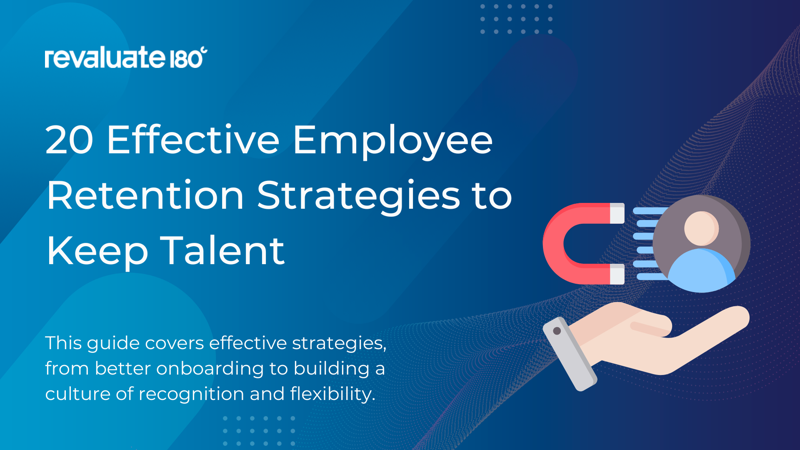According to employee retention statistics, replacing employees can cost up to 20% of their annual salary. It’s high time you revise your employee retention strategies to keep your workforce productive.
High retention rates are generally considered healthy, indicating a turnover rate of 10% or less. In this post, we’ll understand employee retention and the strategies used to mitigate the organization's net loss.
Key Takeaways
- Employee retention is crucial for maintaining productivity, fostering a positive culture, and driving profitability.
- This guide covers 20 powerful, real-world strategies, ranging from compensation and flexibility to leadership and technology, to help you build a high-retention workplace.
- Data-driven solutions like Revaluate180 utilize behavioral data to uncover what truly motivates employees to stay engaged and loyal.
What is Employee Retention?
Employee retention is the force that keeps employees in the organization and minimizes turnover rates. High retention means that most employees are willing to stay with the company and embrace its core values in a world where turnover rates are costly and disruptive.
Since employees want to stay in a company where they feel heard and valued, retention also reflects employee satisfaction and engagement. Companies are willing to benefit employees who are consistent, strong, and more cohesive in their tasks. Gallup research highlights that engaged teams outperform their peers by up to 23% in profitability.
Employees who feel unhappy or underappreciated are also known to not stick around at a given company. For instance, 79% of employees who quit have cited a lack of appreciation as their primary reason for leaving.
20 Effective Employee Retention Strategies
Now that we understand what employee retention is and why it is essential for the organization, let’s explore our top 20 strategies to improve employee retention, where each practice is backed with valuable insights and helps you build a workplace where people want to work.

1. Improve Your Onboarding Process
Making a strong first impression is critical. Studies have shown that 69% of new hires are more likely to stay for three years if they have a great onboarding experience. Effective onboarding helps employees feel connected to their role and the company’s mission.
A well-organized onboarding process ensures clear objectives, introduces team members, and clarifies early and transparent goals. A good mentor to guide them would be very beneficial, as would a daily exercise of gathering feedback for continuous improvement.
Here are some of the essential steps you should consider:
- Start the onboarding process before day one. This is where you can set up welcome materials, tech stack, or essentials that the candidate needs after joining.
- Assign a peer to help answer questions and provide social support whenever needed.
- Set clear goals and milestones for the first tasks that are assigned to the candidates.
- Check in frequently during the first three months to hear them and adjust accordingly to rectify any workplace issues.
2. Hire for Cultural Fit and Future Growth
Hiring the right people is everything. If you want to prevent future turnover, look beyond skills. Consider candidates based on their values, working styles, and potential for growth and development. Employees who are well aligned with your company’s mission are considered a cultural fit.
Behavioral and value-based assignments are the best methods for testing a candidate's potential to thrive in your environment. A Gallup report suggests that ~40% of employees feel their work aligns with the company’s mission, although 93% say that they believe in purpose-driven leadership.
A precise career growth results in an effective culture fit assignment. Here’s what you can do:
- Include culture-oriented questions in the interviews.
- Involve team members in hiring to gauge fit and chemistry.
- Emphasize growth opportunities during the hiring process, such as training programs and career advancement through promotions.
- Use realistic job scenarios to help candidates understand what they can expect if they secure the role.
3. Offer Competitive Compensation and Benefits
Companies pay employees, and in return, they expect benefits for their hard work. As straightforward as it sounds, it’s the global standard for retaining any employee. Research finds that while compensation is essential, many employees value culture and balance even more than their paycheck.
It’s not just the game of money anymore. To retain your top talent, consider offering comprehensive health insurance, attractive retirement plans, and performance-based incentives that align with your company's goals. It’s a mixed bag of financial and non-monetary perks that make a difference. Benefits such as student loan assistance, childcare support, and wellness stipends can be compelling differentiators. Here’s how you can ensure competitive pay:
- Conduct annual compensation reviews to stay competitive in the market.
- Offer benefits that employees value, such as flexible work hours and health plans.
- Provide small bonuses or spot rewards tied to their compensation.
- Publicize the total reward packages, such as leave accrual and perks.
4. Promote Work-Life Balance

Respecting life outside of work is a highly strategic retention tool. Surveys consistently show that work-life balance is a top driving factor for retaining employees within the company. Around 68% of employees are reported to say they’d stay if the company prioritizes work-life balance.
Encouraging your people to take vacations, limiting after-hours emails, and protecting personal time on calendars will keep them engaged and productive at work. Cultivate a system where managers avoid calling off-hours and respect boundaries when necessary. This is when the employees feel trusted and supported.
Here are some of the key things you can cultivate:
- Introduce a right-to-disconnect policy to ensure your teams don’t receive any pings after hours of hard work.
- Publicize vacation days and encourage managers to ensure they’re being used every year.
- Offer flexible work schedules or compressed workweeks whenever possible.
- Provide resources like counseling or workshops related to mental health and stress management.
5. Provide Flexibility and Remote Work Options
Flexible work options are now becoming primary table stakes for many employees. A staggering 75% of remote workers wish to continue with at least some form of remote work, where companies that allow such remote jobs experience roughly 25% lower turnover.
Since work flexibility has proven to boost trust and job satisfaction, it allows employees to work from home with flexible hours or try a four-day workweek policy, and:
- Implement clear guidelines for remote and hybrid work arrangements to ensure consistency and effectiveness. These guidelines should consider tools, work schedules, and time-oriented tasks.
- Equip homes and offices with laptop stipends and ergonomic furniture to enhance productivity.
- Trust employees to manage their time effectively, evaluating their output, rather than focusing on hours.
- Check in regularly with your employees to ensure they’re engaged and connected to their assigned tasks.

Unlock AI-Powered Hiring Analytics
Transform the way you hire with insights that create aligned, collaborative, and high-performing teams.
 Smarter Hiring Decisions
Smarter Hiring Decisions
 Reduce Expensive Turnover
Reduce Expensive Turnover
 AI-Driven Insights
AI-Driven Insights
 Optimize Team Performance
Optimize Team Performance

6. Create a Clear Career Path

People stay when they see their future with your company. Work Institute reports that career issues, specifically a lack of growth opportunities, are the number one reason for quitting. You can counteract this by mapping out career paths for each role, considering your skills, accomplishments, and the time required for the next level in the role.
Offer training programs, career mentorship, or certifications to help them achieve success. Managers should discuss career goals in one-on-one meetings to help create individualized plans that support each employee's unique needs, building a strong growth narrative.
Here are some more actionable steps to set clear career paths:
- Invest in employees’ growth by developing a competency ladder or establishing clear promotional criteria for each department.
- Provide ongoing learning courses or cross-training workshops.
- Encourage lateral moves or special projects to build the necessary skills.
- Publicly recognize promotions and career milestones.
7. Invest in Leadership and Management Development
Bad managers can hurt retention. In fact, nearly 7 out of 10 employees say they’d quit a job because of bad managers. That’s why it’s highly essential to include your leaders when drafting effective retention strategies. Train managers in coaching, communication, empathy, and overall collaboration to ensure they prioritize their team’s career aspirations and job satisfaction.
Good managers must ensure monthly feedback to maintain meaningful relationships with subordinates. Empower managers to recognize the achievements of their employees regardless of their size or impact on profits, and rectify issues before they manifest into a reason for someone’s leave.
- Offer leadership training programs focused on conflict resolution.
- Require new managers to have mentoring from seasoned leaders.
- Evaluate managers based on collective turnover and team engagement rather than numbers and charts.
8. Recognize and Reward Effort
Everyone wants to feel that their work matters. Regular recognition is not just a simple exercise, but also an effective tool for retention. Research at Nectar HR shows that 71% of employees are less likely to leave if recognized more often.
You can appreciate your employees through rewards such as bonuses, awards, and promotions. At the same time, informal gestures like thank-you notes, shout-outs in meetings, and other verbal compliments can go a long way towards maintaining retention goals. Here’s how you can do more:
- Implement structured recognition programs, including spot bonuses and Employee of the Month, among others.
- Encourage leaders to give praise immediately when goals are met.
- Use digital platforms or newsletters to celebrate achievements and birthdays.
- Inquire with your employees about how they prefer to be recognized so they can make a meaningful impact.
9. Build a Strong Company Culture
While engagement keeps employees productive, company culture holds your teams together. Employee retention drastically increases when a positive and inclusive company culture is enforced—a culture where people trust each other at work while living life with the core values that align with your company.
Encourage social connection through virtual or in-person team rituals where teams gather for a coffee, have lunch, or go on off-sites. Since 83% of employees believe a positive work environment is crucial for their loyalty, let’s look at some more actionable steps you can take to build a strong company culture:
- Define and frequently communicate your organizational goals with your teams.
- Create feedback loops in the form of surveys and act on the input, rather than just manipulating numbers.
- Organize team-building activities such as volunteer days, social events, and workshops.
- Tackle any toxic behaviour decisively and promote inclusivity and respect at all levels of hierarchy.
10. Make Employee Feedback Actionable
Listening to your employees’ problems is the first step. But taking actionable steps based on the feedback you obtain is the next step. Conduct regular surveys, pulse checks, and interviews to understand what’s happening inside your employees’ heads and sentiments.
After gathering the necessary info, act on what you’ve learned from the data. For example, suppose exit interviews reveal concerns about poor communication and a lack of opportunities for growth. In that case, it’s your responsibility to implement specific programs to address and rectify these issues, such as anonymous surveys, among others.
- Use these anonymous surveys to regularly gauge morale and engagement.
- Conduct stay interviews with long-tenured employees to determine why they remain with the organization.
- Share survey results openly and create an action plan with a proper deadline.
11. Foster Team Collaboration and Bonding
A sense of belonging can help employees stay because they feel heard and supported. You must maintain a narrative that encourages open communication and can be initiated through cross-functional project collaboration. For example, a Slack channel for non-work chat or a lounge in the office. It’s no surprise that we found out that close work friendships can boost satisfaction levels by up to 50%, as reported by the Harvard Business Review.
Collaboration also means breaking the silos. Rooms for interdepartmental meetings, also known as ‘lunch-and-learns’, can become an opportunity to learn from your colleagues and appreciate different roles. Here’s more you can do to foster team bonding:
- Organize regular team meetings and cross-team projects, among others.
- Plan informal activities, such as playing games, office outings, and virtual coffee breaks, for those working remotely.
- Encourage teams that want to share knowledge and those seeking career mentorship.
- Celebrate team achievements together to reinforce unity and camaraderie.
12. Personalize the Employee Experience
Every employee is unique. When it comes to retaining top talent, you must ensure that your retention techniques are tailored to each employee. To achieve this, you can ask them to choose their benefits and working styles that suit them whenever necessary.
For example, provide them with a list of perks, such as a gym membership or paid time off, instead of just one option for everyone. How to know which options to give? You can do one-on-ones to understand individual career aspirations and motivators.
- Allow flexible benefits that are allocated after conducting a personalized survey. Let your employees pick what matters most to them.
- Creative Individual Development Plans (IDPs) to create personalized policies.
- Check in about work preferences, including communication style and feedback frequency, among others.
- Customize roles or projects that are designed to leverage each person’s strengths.
13. Support Employee Well-Being
Employee well-being has been a key to retention since we observed how holistic health can benefit productivity. Burnout or stressed employees are far more likely to quit, and stressed workers are 2.6 times more likely to seek better opportunities elsewhere.
To avoid this, you can provide various options to support well-being:
- Provide access to mental health resources such as EAPs, therapy apps, stress relief, and management workshops.
- Ensure you’re mindful of your body and use standing desks for work, incorporate walking meetings, or participate in on-site fitness classes.
- Support work-life balance and set clear boundaries.
- Train managers to recognize signs of burnout and regularly check in on team well-being.
14. Build Trust and Transparency

There is no business without service, and there is no good service without trusting your employees. Trust is a cornerstone of retaining your talent, as it’s the most critical factor in keeping your employees within your company.
A transparent culture reduces rumors and anxiety, which can otherwise introduce a toxic culture no one wants to be a part of. Here are some practical examples of how to build trust and transparency.
- Hold regular ‘ask me anything’ forums with the leadership.
- Publish key metrics such as employee survey insights and business performance results, and have an open narrative.
- Follow through on commitments! We understand that it can be challenging to keep track of everything. This is especially true where numerous issues need to be rectified. Take one step at a time, but don’t bury the issues in the HR register. Be the change by implementing them.
15. Promote Diversity, Equity & Inclusion (DEI) Initiatives
A sense of belonging is what people need to stay with a company. Prioritizing diversity, equity, and inclusion (DEI) will help 78% of your employees to show up at work every day. That’s when you know a good DEI policy can make or break your culture.
Offer bias training to ensure your hiring and promotion processes are ethical and inclusive of all individuals. Support affinity groups or resource networks to expose underrepresented talent.
- Create Employee Resource Groups (ERGs) and provide support whenever needed.
- Include DEI goals in leadership through performance evaluations.
- Ensure representation in leadership to highlight diverse role models.
- Conduct feedback from diverse teams with ethical evaluation.
16. Measure and Monitor Retention Metrics
You can manage what you can measure, and measuring the key retention metrics is the most crucial step in gathering valuable insights. Track key retention-related metrics to spot early trends. These key metrics include the overall turnover rates, retention rates, and new hire turnover by department. If your turnover rates are spiking, you can design personalized steps to tackle this issue.
- Calculate retention and turnover rates on a monthly or quarterly basis.
- Conduct and analyze exit interviews to identify the most common patterns that hinder productivity.
- Track participation in development programs and see how it correlates with retention.
- Utilize predictive analytics to identify and resolve issues before they occur.
17. Empower Employees With Autonomy
Trust cannot be gained by controlling how your employees work. Workers who have control over how they work tend to be more trustworthy and loyal to their jobs. Giving people autonomy to make their decisions will help set clear goals and represent your company’s faith in them.
Here’s how you can increase commitment by offering flexibility and freedom to make their decisions for themselves:
- Delegate projects end-to-end to individuals or teams rather than dictating every single task. Micromanaging only leads to more chaos.
- Encourage initiative, especially when someone has a great idea, and let them lead.
- Offer choice in task assignments whenever possible and avoid any overly rigid approval layers. Just ask for updates rather than permissions.
18. Create a Purpose-Driven Workplace
Meaning and purpose can certainly promise long-term engagement. Showing your employees how their work impacts customers, communities, and the company’s mission helps them believe in what they do and stay motivated.
For example, if your company’s mission is sustainability, involve everyone in the green initiative and measure those outcomes. An organization with a strong mission certainly sees higher retention rates. Among others:
- Tie performance to mission outcomes by setting certain margins, like this project helps X customers.
- Share customer success stories or testimonials that highlight the impact of your employees.
- Encourage teams to set their personal success goals so they can feel motivated to achieve them.
19. Align Company and Employee Values
We just talked about purpose. However, a set of values defines your purpose, which encourages longevity. Employees stay when their values match the company’s. Do you know that only 40% of workers feel their job is truly purposeful? The data suggest that you must ensure their personal and organizational values are well-aligned during the recruitment process.
For example, if a company claims to care about innovation but only rewards conformity, employees may be quietly disengaged. On the other hand, celebrating integrity, collaboration, and customer focus will consistently encourage employees to live fully.
- Include value-related questions in the interview, such as “Which company values resonate with you the most?”
- Train managers to recognize and reinforce behaviours that reflect core beliefs.
- Conduct periodic workshops where teams can reflect on actually living their mission.
- Recognize employees who exemplify values and translate their achievements into rewards or internal recognition.
20. Know When to Let Go (Graceful Exits)
Ironically, part of the retention strategy involves planning for the graceful departures of your employees when it’s time for them to leave. Sometimes an employee won’t fit, no matter how hard you try, and that’s when you risk poisoning your morale. Exit interviews are a valuable way to gather honest feedback and gain insight into why someone is leaving, allowing you to use these insights to improve your workplace.
- Standardize exit interviews by asking open-ended questions that focus on work experience.
- Analyze exit data quarterly to spot systemic issues. Is it a lack of growth or communication?
- Offer departing employees closure to understand their side of the reason for leaving the company.
Using Data-Driven Solutions to Boost Retention
Modern analytics can supercharge the retention strategies. At Revaluate180, we combine organizational psychology and behavioural analytics to generate the best outcomes. Using data on engagement values, teamwork dynamics, and values, our platform identifies early insights at scale.
Our AI-driven data model will help you gain quantifiable insights across the employee lifecycle, enabling leaders to see evidence-based recommendations, such as who needs coaching. Which teams lack cohesion? Also, where are the values diverging? We turn our performance data into actionable steps to focus on retention efforts where they’ll have the most significant impact. Contact us today to benefit from our most successful models for maximizing, developing, and retaining your top talent.
FAQs
What are 5 ways to improve employee retention?
The five standard ways to improve retention are:
- Build Strong Onboarding
- Provide Career Development
- Recognize and Appreciate
- Encourage Work-Life Balance
- Improve Manager-Employee Relationship
What are the 3 R’s of employee retention?
Respect, Recognition, and Rewards are the three central R’s of employee retention.
What are the best employee retention strategies?
The most effective retention strategy has been offering competitive pay and benefits to ensure personal growth.
What are the 5 key factors that drive retention?
The five main factors that drive retention are:
- Career Development Opportunities
- Work Environment and Culture
- Work-Life Balance and Flexibility.
- Good Leadership and Management.
- Rewards and Recognition
What’s a good retention rate to aim for?
A retention rate of 90% or higher is generally considered healthy, corresponding to the overall turnover of 10% or less per year.
